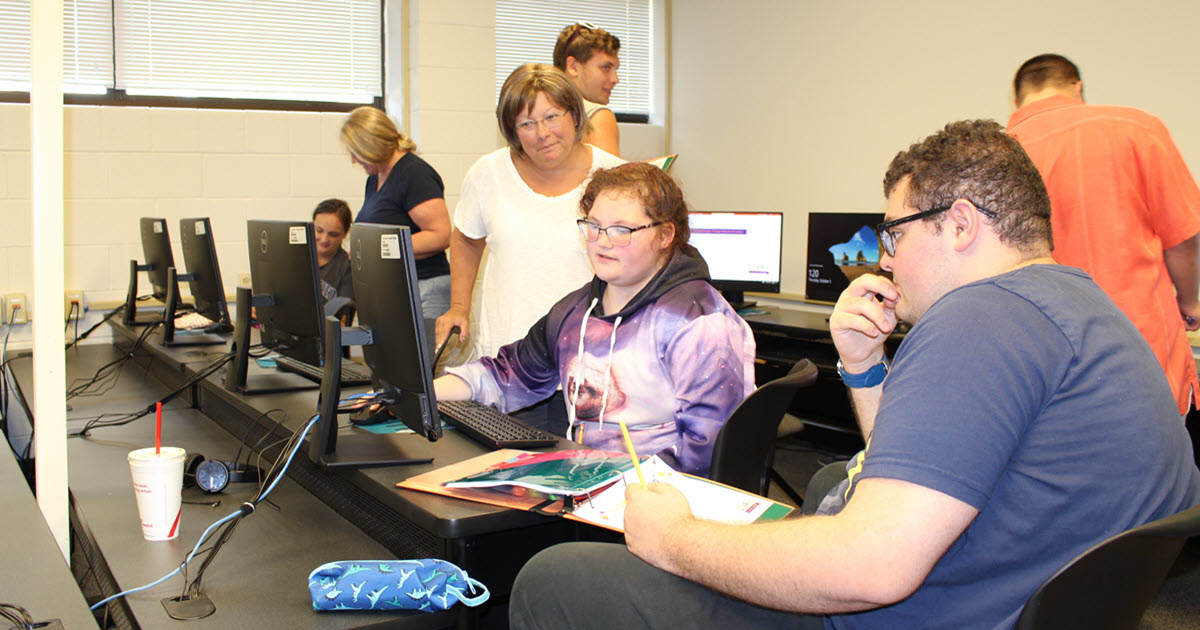Targeted Interventions, 504 Plans, and IEPs Explained for Parents
The school year may have just started, but signs that your child needs extra support can appear quickly. Teachers might express concerns about reading or other subjects, homework may become a nightly struggle, or your child might come home frustrated, saying they “just don’t get it.”
When this happens, many parents wonder how to get help—but the process can feel overwhelming. The good news is that schools offer several ways to support struggling students, and you don’t have to navigate it alone. Understanding the difference between targeted interventions, 504 plans, and IEPs can help you advocate for your child and work effectively with their school team.
Understanding Your Child’s Support Options in School
When your child struggles in school, there are three main pathways for support, each designed for different needs and circumstances.
Targeted Interventions are often the first step when teachers notice a student needs extra support. These are additional teaching strategies or small group instruction that happen within the general education setting. Your child might work with a reading specialist twice a week, join a small math group, or participate in “lunch bunch” social skills activities. These supports can be incredibly effective and don’t require formal documentation or meetings.
The key thing to understand is that receiving targeted interventions doesn’t mean there’s a major issue with your child. Targeted interventions are used when there is an area of classroom performance that the school wants to address. This simply means that the school is being proactive about meeting the students’ needs.
504 Plans are designed for students who have a diagnosed condition that impacts their ability to access their education, but who don’t need specialized instruction. These plans are governed by the Americans with Disabilities Act and focus on removing barriers to learning. The student can understand and learn the material being taught; they just need accommodations to access it effectively.
IEPs (Individualized Education Programs) are for students who need specialized instruction due to a disability that impacts their access to their learning environment. These students require teaching methods, materials, or approaches that are different from what’s typically used in general education classrooms. This is governed by the Individuals with Disabilities Education Act and provides comprehensive support from birth through age 21.
| Type of Support | What It Is | Who It’s For | Examples of Support Provided |
|---|---|---|---|
| Targeted Intervention | Short-term, school-based support designed to help students who are struggling academically or behaviorally before a formal plan is needed. | Students who are falling behind in specific areas (like reading or math) but who may not have a diagnosed disability. | • Work with a reading specialist • Join a small math group • Participate in “lunch bunch” for social skills |
| 504 Plan | A formal plan that ensures students with disabilities have equal access to learning under Section 504 of the Rehabilitation Act of 1973. | Students with a physical or mental impairment that limits one or more major life activities but who do not require special education. | • Classroom accommodations such as extended test time • Preferential seating • Assistive technology • Modified assignments |
| Individualized Education Program (IEP) | A detailed, legally binding plan for students who qualify for special education under the Individuals with Disabilities Education Act (IDEA). | Students with a diagnosed disability that affects their educational performance and requires specialized instruction. | • Specialized instruction • Related services, like speech therapy, OT, PT • Setting goals and having progress reports |
Start the Conversation with Your Child’s Teacher
The moment you notice concerns about your child’s academic progress or behavior, start by connecting with their teacher. This isn’t about pointing fingers or expressing frustration. Instead, approach it as the beginning of a collaborative partnership focused on your child’s success.
During this initial conversation, ask specific questions about what the teacher is observing, such as:
- Are they noticing the same struggles you see at home?
- Are there certain times of day or subjects where my child seems to struggle the most?
- Have they already started any targeted interventions in the classroom?
Many teachers begin informal supports immediately when they notice a student struggling, such as providing additional practice, changing seating arrangements, or offering different ways to demonstrate understanding.
Your child’s teacher might share that they’ve already implemented several strategies. Perhaps your child is receiving small group reading instruction, working with a math specialist, or getting extra support during independent work time. These targeted interventions can be highly effective and might be exactly what your child needs to get back on track.
The important thing is to establish open communication and regular check-ins about your child’s progress. Remember that having this conversation doesn’t mean you’re admitting there’s something “wrong” with your child. When families and teachers work together, it helps everyone feel more confident and reduces anxiety about what comes next.
Document Concerns and Gather Information
Keep simple notes about your child’s struggles, what strategies the teacher is trying, and how your child responds.
Documenting this helps you:
- Share concrete examples with school staff.
- Track whether current targeted interventions are working.
- Provide useful data if a formal evaluation is needed later.
Look for patterns:
- Are challenges specific to reading, math, or written instructions?
- Do struggles happen at certain times of day?
- Are there health or mental health conditions that might be affecting learning?
These details help the school team understand your child’s needs and determine the right support.
Allow Time for Targeted Interventions to Work
Once targeted interventions begin, give them time to work—schools typically monitor progress for several weeks or months. This allows teachers to gather meaningful data about your child’s response. Stay in touch with the teacher during this period. Ask for regular updates on progress and how the targeted interventions are going. Some schools provide formal progress reports, while others share updates through email or quick check-ins.
If the targeted interventions are helping, celebrate the progress! Many students catch up with this level of support and don’t need further services.
Understanding the 504 and IEP Referral Process
When classroom targeted interventions aren’t sufficient to address your child’s needs, the next step is often a formal referral for evaluation. This process begins with the school team collecting informal data about your child’s performance and the targeted interventions that have been tried.
The school team—which you are also a part of and are invited to and should participate in—typically includes your child’s teacher, a school administrator, and other relevant staff members, will review all available information. This might include classroom observations, grades, work samples, and information about your child’s response to targeted interventions. As a parent, you’ll be asked to provide input about what you’re seeing at home and any concerns you have about your child’s progress.
This informal data collection helps the team determine whether your child might benefit from a 504 plan or whether they should be referred for IEP evaluation. The decision is based on whether your child needs accommodations to access their education or whether they require specialized instruction to make meaningful progress.
It’s important to understand that you can request this evaluation process at any time, and you can make this request more than once if circumstances change. Schools are required to consider parent requests for evaluation, though they’re not required to automatically conduct testing just because it’s requested.
Navigating 504 Plan Development
If the school team determines that your child has a diagnosed condition that impacts their access to education but doesn’t require specialized instruction, they may be eligible for a 504 plan. This process is typically faster and less formal than IEP development.
A 504 plan focuses on accommodations that remove barriers to learning. These might include extended time on tests, frequent breaks, preferential seating, or modified homework assignments. The goal is to ensure your child can access the same curriculum and instruction as their peers, just with some adjustments to how it’s delivered or how they demonstrate their learning. Unlike the IEP process, a 504 plan is usually initiated when a teacher or family member recognizes that a student may need additional supports and requests a 504 meeting. The school then gathers information to determine eligibility and develop the plan if appropriate. The 504 team will meet annually to review your child’s plan and make any necessary changes. Every three years, they’ll conduct a more comprehensive review to determine continued eligibility. As your child grows and their needs change, the accommodations can be adjusted accordingly.
Common accommodations in 504 plans can include:
Providing directions in multiple formats – Some students learn best when information is presented in more than one way. A teacher might give verbal instructions, write them on the board, and provide a printed or digital copy. This approach can help students with learning disabilities, ADHD, or auditory processing challenges stay organized and understand expectations clearly.
Allowing the use of fidget tools – Small items like stress balls, putty, or textured objects can help students who have difficulty sitting still or focusing for long periods. For students with ADHD, autism, or sensory processing needs, fidget tools can support concentration and self-regulation without disrupting the class.
Giving extra time for assignments – Students who process information more slowly, have fine motor challenges, or experience anxiety may benefit from extended time to complete their work. This accommodation helps ensure they can demonstrate what they’ve learned without being limited by time constraints.
These supports are designed to be seamlessly integrated into the classroom routine.
The IEP Evaluation Process
If your child needs specialized instruction rather than just accommodations, the school team may recommend a special education evaluation. This is a more comprehensive process that examines multiple areas of your child’s development and learning.
Your IEP evaluation team might include:
- A school psychologist
- Special education teacher
- Speech-language pathologist
- Occupational therapist
- Other specialists depending on your child’s needs.
They’ll conduct various assessments to understand your child’s strengths and challenges in areas such as academics, communication, social-emotional development, and daily living skills.
It’s crucial to understand that having a diagnosis doesn’t automatically qualify your child for an IEP. The evaluation must demonstrate that your child’s disability significantly impacts their ability to access their education and that they require specialized instruction to make meaningful progress. Some students with diagnoses like dyslexia or ADHD might be better served through 504 plans or classroom targeted interventions.
The evaluation process typically takes several weeks to complete, and you’ll receive a comprehensive report detailing the findings. If your child is found eligible for special education services, the team will develop an IEP that outlines specific goals, services, and supports.
Examples of possible IEP accommodations could be:
Speech therapy – for students who have difficulty with articulation, language development, or communication skills. For example, a student who struggles to form certain sounds or has challenges expressing their thoughts clearly may work with a speech-language pathologist to build stronger communication skills that support both learning and social interaction.
Modified curriculum – for students who learn best when academic content is adjusted to their individual level. This could mean simplifying assignments, breaking tasks into smaller steps, or focusing on essential skills rather than grade-level standards. A student with an intellectual disability, for instance, might follow a curriculum tailored to their learning pace while still participating in classroom activities alongside peers.
Alternative ways of presenting information – for students who need different formats to access lessons. This might include using visual aids, audio recordings, hands-on activities, or assistive technology like text-to-speech software. For example, a student with a visual impairment might receive materials in large print or digital format, while a student with a learning disability might benefit from hearing instructions read aloud.
Partnering with Your Child’s School
No matter which support path your child takes, their success depends on a strong home-school partnership. Share what works for your child, maintain open communication, and stay actively involved. Set a reasonable schedule for updates—weekly or bi-weekly check-ins often work well—so you stay informed without overwhelming school staff.
Advocate for your child while respecting the expertise of teachers and specialists. The best results come when families and schools work together toward shared goals. Keep in mind that support is ongoing and may change as your child grows. What works now may need to be adjusted in later grades to match your child’s development and needs.
You Don’t Have To Do It Alone
If your child requires an IEP, you don’t have to navigate this often-overwhelming process alone. Fello offers programs like Project Learn and Project Learn Leadership Academy, specifically designed to support families and students through their IEP journey. Whether you need one-on-one coaching to review your child’s IEP and prepare for meetings or want your student to better understand and participate in their plan, these programs provide guidance, advocacy tools, and confidence every step of the way.
Learn more about Project Learn and Project Learn Leadership Academy


